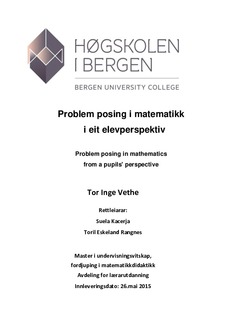| dc.contributor.author | Vethe, Tor Inge | |
| dc.date.accessioned | 2018-02-01T15:22:43Z | |
| dc.date.available | 2018-02-01T15:22:43Z | |
| dc.date.issued | 2015-09-04 | |
| dc.identifier.uri | http://hdl.handle.net/11250/2482249 | |
| dc.description | Masteroppgave i undervisningsvitenskap | en_GB |
| dc.description.abstract | Denne masteroppgåva søker å identifisere kvalitetar ved bruk av problem posing i matematikkundervising ut frå eit elevperspektiv. Problem posing er i denne oppgåva forstått både som grep og omgrep. Medan problem posing som grep omhandlar reiskap for å oppnå læring, handlar problem posing som omgrep om det innhald som ligg i reiskapen. For å få innsikt i opplevingar og erfaringar elevar kan få ved problem posing-aktivitet, vart det søkt etter kvalitetar gjennom to inngangar: ein inngang søker innsikt i kvalitetar knytt til elevrefleksjon om problem posing-aktivitet, og ein inngang søker innsikt i kvalitetar knytt til elevarbeid i problem posing-aktivitet. Gjennom matematisk modellering, fekk elevgrupper full fridom til å gjennomføre eit matematisk prosjekt dei sjølv hadde valt. Dei var sjølve ansvarlege for gjennomføring, noko som inkluderte å ta stilling til problem som undervegs måtte oppstå. Gjennom prosjektet vart problem posing innført som eit reiskap som elevar kunne nytte for å søke etter alternative spørsmål, løysingar og metodar. På bakgrunn av erfaringane elevane gjorde seg, vart det gjennomført fokusgruppeintervju. Gjennom analysearbeid vart det søkt etter kjenneteikn på kvalitetar ved problem posing. Der vart identifisert fleire kvalitetar ved problem posing som kan verke inn på elevar si matematikklæring. Eksempelvis opna problem posing for elevar sine eigne vurderingar og refleksjon kring oppgåver si vanskegrad. Elevar synar òg at dei evnar å danne eigne, gjennomførbare problemstillingar. Elevar evnar òg å tilpasse problemstillingar undervegs og finne hensiktsmessige metodar for å kunne løyse problemet | en_GB |
| dc.description.abstract | This master thesis seeks to identify qualities in using problem posing in teaching mathematics from a pupils' point of view. In this thesis, problem posing is understood as both a didactical tool and a term. While problem posing in the first sense is seen as a tool for achieving learning, problem posing as term relates to the content that is included in the tool. In order to gain access to experiences pupils can get with problem posing activities qualities were sought for through two points of view: insight through pupils' reflections about problem posing activity, and insight through pupils' work in problem posing activity. Through mathematical modeling, pupils were given complete freedom to implement a mathematical project they wanted to investigate. The pupils were responsible for the whole implementation, including solving problems which could occur during the modeling process. Problem posing was introduced as a tool that pupils could use in searching for alternative questions, solutions and methods. Focus group interviews were used to gain access to pupils' experiences with problem posing. Characteristics of qualities of problem posing were sought for during the analysis. Several qualities of problem posing were identified which affect pupils' learning in mathematics. An example is how problem posing was opening opportunities for pupils' evaluations and reflections about the difficulty level of their assignments. Further, pupils showed they are able to formulate their own problems to solve, which includes ability to adapt questions during a modeling project and to find appropriate methods to solve the problem | en_GB |
| dc.language.iso | nno | en_GB |
| dc.subject.other | matematikk | en_GB |
| dc.subject.other | elevperspektiv | en_GB |
| dc.title | Problem posing i matematikk | en_GB |
| dc.title.alternative | Problem posing in mathematics | en_GB |
| dc.type | Master thesis | en_GB |
